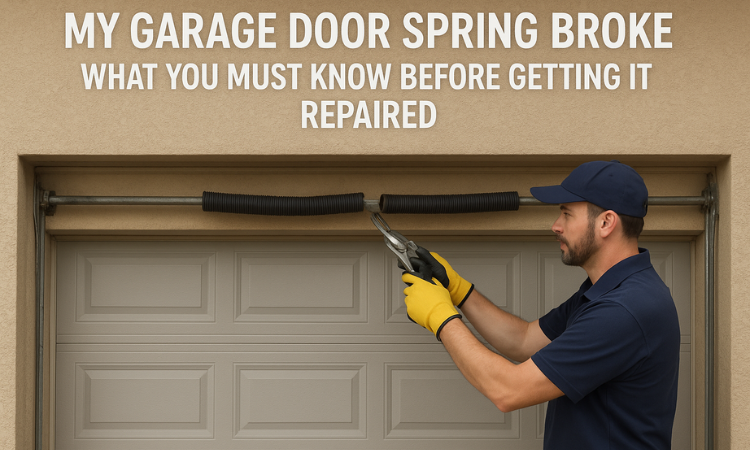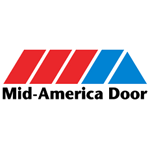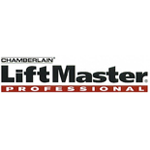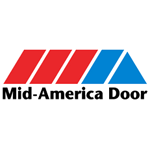A loud “bang” from the garage is a sound no homeowner wants to hear. If you tried to open your garage door afterward and it wouldn’t budge, you likely have a broken garage door spring. This is one of the most common and critical garage door repairs. Before you pick up the phone to call for a repair, it’s important to understand what happened, the safety risks involved, and what to expect from the repair process. This guide covers everything a New York homeownerGarage Door Spring Repair needs to know when facing a broken garage door spring.
1. What Happens When a Garage Door Spring Breaks?
The springs on your garage door are responsible for counterbalancing its weight, which can be several hundred pounds. They do the heavy lifting so the opener doesn’t have to. When one breaks, the system loses its balance and power, leading to a few distinct signs.
Signs Your Spring Has Snapped
The most obvious sign is that your garage door won’t open, even when you use the opener or try to lift it manually. You may also see a visible gap of a few inches in the spring itself. If your door has two springs, one will still be intact while the other is clearly separated. You might also notice that the lifting cables have become slack or have come off their drums.
Why the Door Won’t Open Anymore
Without the immense force from the springs, your garage door opener isn’t powerful enough to lift the full weight of the door. The springs counterbalance hundreds of pounds, and when they fail, that entire weight is left for the opener or you to lift. Trying to force it open can damage the opener’s motor, bend the door panels, or cause other serious issues.
The Loud “Bang” Sound Explained
The loud noise you heard is the sound of the spring, which is under extreme tension, releasing its energy instantly as it breaks. The metal coil snaps with incredible force, creating a sound often compared to a firecracker or even a gunshot. This sound is a clear signal that a spring has failed.
2. Types of Garage Door Springs (and Which One You Have)
Garage doors use one of two main types of spring systems. Identifying which one you have can help you understand the repair process.
Torsion vs. Extension Springs
Torsion springs are the most common type on modern garage doors. This is a large, single spring (or a pair of springs) mounted on a metal shaft directly above the garage door opening. As the door closes, the springs wind up, storing energy. As it opens, they unwind, using that energy to lift the door.
Extension springs are an older system. These are two smaller springs located on either side of the door, running parallel to the horizontal tracks. They work by stretching and contracting like a rubber band to support the door’s weight.
How to Identify Your Spring Type
Look above your closed garage door. If you see one or two large, coiled springs running across a bar, you have torsion springs. If you see springs running along the sides of the door near the ceiling, you have extension springs. Extension springs often have safety cables running through them to prevent them from flying across the garage if they break.
Which Springs Last Longer in New York Weather Conditions
Torsion springs are generally considered safer, more durable, and longer-lasting than extension springs. They provide a smoother, more controlled motion. New York’s humidity and fluctuating temperatures can cause rust and wear on any spring, but torsion springs are less exposed and tend to hold up better over time.
3. Why Garage Door Springs Break
A broken spring isn’t necessarily a sign of a faulty door; it’s often an expected part of the system’s life cycle.
- Natural Wear and Tear: Springs are rated for a certain number of cycles (one cycle is one full opening and closing). The standard lifespan is around 10,000 to 20,000 cycles. If you use your garage door multiple times a day, you can reach this limit in just a few years.
- Rust and Corrosion: The humidity in New York, especially during the summer, can cause rust to form on the springs. Rust weakens the metal coil, creating friction and increasing the likelihood of it snapping.
- Lack of Maintenance: Springs need to be lubricated regularly to reduce friction and prevent corrosion. Without proper maintenance, their lifespan can be cut short significantly.
- Imbalanced Door or Misaligned Tracks: If your garage door is not perfectly balanced, the springs must work harder on one side, leading to uneven wear and premature failure.
- Cold Weather Brittleness: Extreme cold can make the metal coils more brittle and susceptible to breaking, especially when under tension.
4. Safety Risks When a Spring Breaks
A broken spring makes your garage door a significant safety hazard. The door is incredibly heavy and can become unpredictable.
Why Attempting to Open the Door is Dangerous
Trying to operate the opener with a broken spring can burn out the motor or strip its gears. Attempting to lift the door manually is even more dangerous. Without the springs to assist, you are trying to lift the full, dead weight of the door. If you lose your grip, the door can slam shut with enough force to cause serious injury or damage.
Risks of DIY Replacement
Garage door springs are under extreme tension. Attempting to replace them without the proper training and specialized tools is extremely dangerous. Torsion springs, in particular, must be wound under immense pressure. If a winding bar slips or the spring is not secured correctly, it can unwind violently, causing severe or even fatal injuries.
Common Injuries from Spring Tension
Injuries from DIY spring repair include deep lacerations, broken bones, eye injuries from flying metal, and crushed fingers or limbs. This is not a task for a weekend handyman; it requires a trained professional.
Protecting Your Family and Property
Until a professional can repair it, treat your garage door as out of service. Keep children and pets away from the door. Do not try to force it open or closed. If possible, disconnect the garage door opener to prevent anyone from accidentally trying to use it.
5. Can You Open the Door With a Broken Spring?
While it is physically possible in some cases, it is highly discouraged.
Why It’s Difficult or Impossible
Lifting a garage door without spring assistance requires immense strength. It often takes two or more strong adults to lift it, and holding it open is another challenge. The door can easily slip and come crashing down.
Emergency Release Guidelines
If you absolutely must get your car out, you can use the emergency release cord. This red cord hangs from the opener track and disconnects the door from the opener’s trolley. Once disconnected, you will need at least one other person to help you manually lift the door. Lift slowly and carefully. Once open, use sturdy supports like locking pliers clamped onto the tracks to hold the door in place. Never stand or walk under a door propped open this way.
Safe Alternatives if Your Car is Stuck Inside
The safest option is to leave your car in the garage until the spring is repaired. Most reputable New York garage door companies offer same-day or emergency service. It is better to use a ride-share service or borrow a car for a day than to risk injury.
6. DIY vs. Professional Repair — What You Should Know
While some garage door maintenance is DIY-friendly, spring replacement is not one of them.
What Homeowners Can Safely Check
You can safely inspect your door for visible signs of a broken spring, check for frayed cables, and look at the alignment of your tracks. You can also lubricate moving parts like hinges and rollers. However, do not touch the springs or the high-tension components connected to them.
Why Spring Replacement Isn’t a DIY Task
The primary reason is safety. The stored energy in a garage door spring can be lethal if released improperly. Professionals have specialized tools, including winding bars that fit snugly into the spring’s winding cone, and the training to release tension safely.
Tools Required (and Why Homeowners Shouldn’t Use Them)
Professionals use calibrated winding bars, cable tensioning tools, and heavy-duty clamps. Using substitutes like screwdrivers or rebar is extremely dangerous, as they can slip out under pressure and become projectiles.
Required Measurements for Correct Spring Pairing
Replacing a spring isn’t a one-size-fits-all job. The replacement spring must perfectly match the old one in wire size, diameter, and length to correctly balance the door’s weight. A professional will take precise measurements to ensure the right spring is installed. An incorrect spring can cause the door to open or close too quickly, damaging the door and opener.
7. How Much Does Garage Door Spring Repair Cost in New York?
Costs can vary based on your location within New York, the type of spring, and the extent of any other damage.
Typical NYC/Queens Repair Pricing
In areas like NYC, Queens, and Long Island, homeowners can expect to pay anywhere from $250 to $500 for a standard spring replacement. This price usually includes the cost of the spring(s) and the labor. Be wary of quotes that seem too low, as they may involve hidden fees or low-quality parts.
Cost Differences Between Torsion & Extension Springs
Torsion spring replacement is often slightly more expensive than extension spring replacement due to the complexity and risk involved. However, if you are replacing extension springs, it is highly recommended to have safety cables installed, which may add to the total cost.
Additional Repairs That Affect the Price
If the technician discovers other worn parts during the inspection, such as frayed cables, worn-out rollers, or a damaged bearing plate, they will recommend replacing them. Addressing these issues at the same time can prevent another service call and ensure the system works smoothly. It is also standard practice to replace both springs at once, even if only one broke.
How Long the Repair Takes
A professional technician can typically complete a standard spring replacement in 30 to 60 minutes. They have the experience and tools to work efficiently and safely.
8. What to Expect During a Professional Spring Repair
A reputable technician will follow a clear, professional process.
- Safety Inspection: The technician will begin with a thorough inspection of the entire garage door system—including springs, cables, rollers, pulleys, and tracks—to identify any other worn or damaged parts.
- Spring Replacement Process: They will secure the door, safely release any remaining tension, remove the old springs, and install the new ones. For torsion springs, they will carefully wind them to the precise tension required to balance your specific door.
- Cable and Hardware Tuning: The technician will check and adjust the lift cables to ensure they are properly tensioned and seated on the drums. They will also tighten all nuts and bolts.
- Balance Test & Final Adjustments: After installation, the technician will perform a balance test. This involves disconnecting the opener and manually lifting the door to the halfway point. A properly balanced door should stay in place. They will make final adjustments to the spring tension as needed and lubricate all moving parts.
9. Preventing Future Spring Breaks
Proper maintenance is key to maximizing the lifespan of your new springs.
- Lubrication Schedule: Spray the springs with a garage door-specific lubricant every three to four months to reduce friction and prevent rust. Do not use heavy grease like WD-40, which can attract dirt.
- Checking Balance & Tension Regularly: Twice a year, perform a balance test. If the door flies up or slams shut, the springs need adjustment by a professional.
- When to Replace Both Springs at Once: Springs are installed at the same time and endure the same number of cycles. If one breaks, the other is likely not far behind. Replacing both at once saves you money on a future service call and ensures the door remains balanced.
- Seasonal Maintenance Tips for New York Climates: Before winter, ensure all moving parts are lubricated to prevent them from freezing or sticking. In the spring, clean away any salt or debris that may have accumulated over the winter to prevent corrosion.
10. How to Choose the Right Garage Door Repair Company in New York
Not all repair companies are created equal. Look for these signs of a trustworthy professional.
- Licensing & Insurance: Ensure the company is licensed to operate in your area and carries full liability insurance to protect you in case of an accident.
- Same-Day Service Availability: A broken spring can be an emergency. A good company will offer same-day or 24/7 emergency service.
- Warranty on Parts and Labor: Reputable companies stand behind their work with a warranty on both the new springs and the labor.
- Red Flags: Be cautious of companies that provide a vague quote over the phone without an inspection, pressure you into unnecessary upgrades, or use unmarked service vehicles. Check online reviews and ask for recommendations.
11. When to Replace the Entire Garage Door Instead of Just the Spring
Sometimes, a broken spring is a symptom of a larger problem. It may be more cost-effective to replace the whole door if:
- The door is very old (15+ years) and showing signs of significant wear, like rot or rust.
- You have experienced repeated spring failures, which could indicate a door that is too heavy or poorly matched to its hardware.
- The tracks, cables, and opener are also in poor condition, and the cumulative cost of repairs is approaching the cost of a new door.
- You want to upgrade for safety and efficiency, as modern doors offer better insulation and safety features.
12. Final Checklist Before Getting Your Garage Door Spring Repaired
You are now prepared to handle this repair confidently. Here is a final checklist:
Do’s and Don’ts
- DO keep everyone away from the door until it’s fixed.
- DON’T try to repair the spring yourself.
- DO call a reputable, licensed, and insured professional.
- DON’T go with the cheapest quote without verifying the company’s credibility.
Questions to Ask Your Repair Company
- Do you offer a warranty on parts and labor?
- Are your technicians licensed and insured?
- Does the quote include replacing both springs?
- Is the service call fee included in the total price?
How to Make Sure You’re Not Overpaying
Get quotes from two or three reputable companies. Ask for an itemized breakdown of costs, including parts and labor. A transparent company will be happy to explain their pricing. By being an informed customer, you can ensure you get a fair price for a safe, professional, and lasting repair.













































